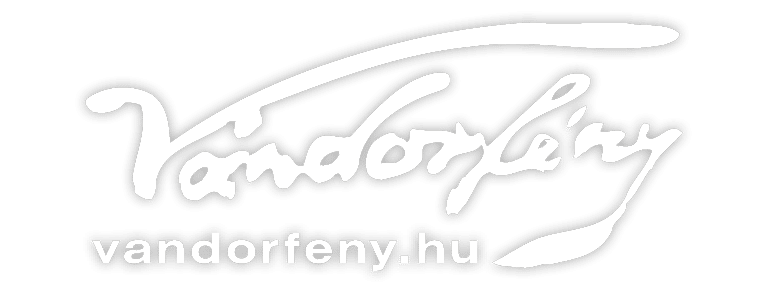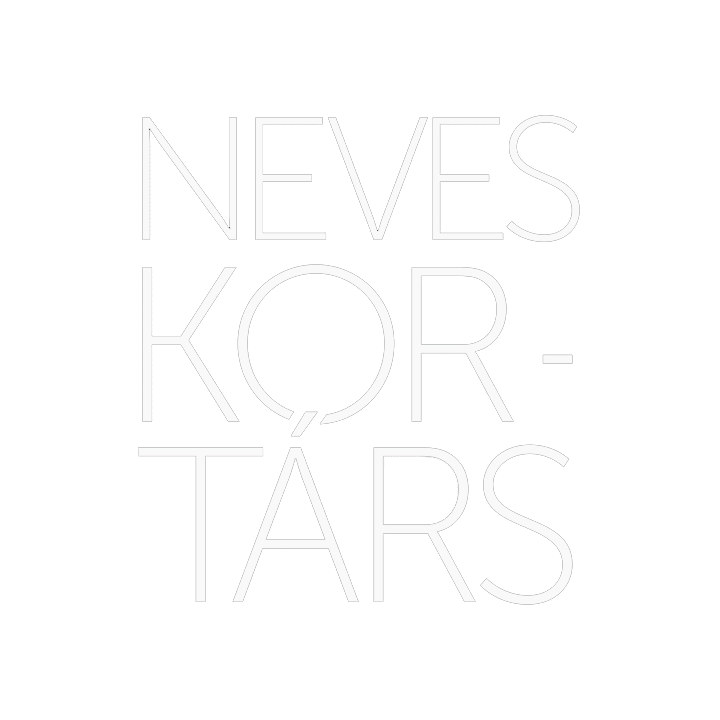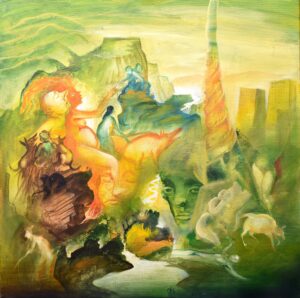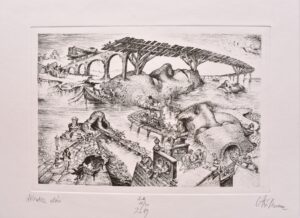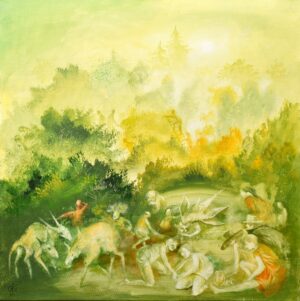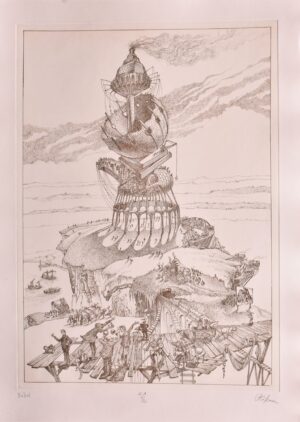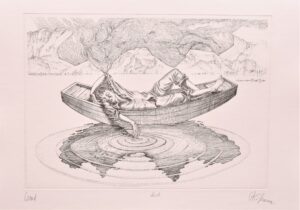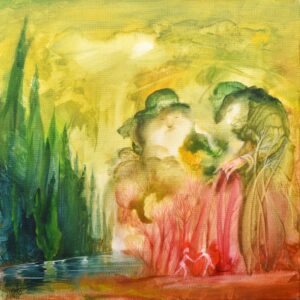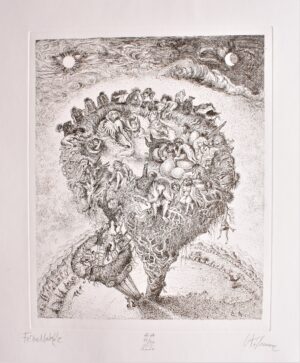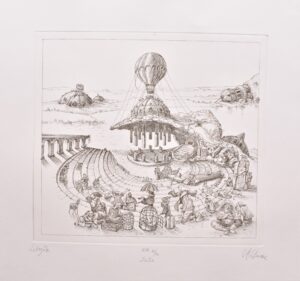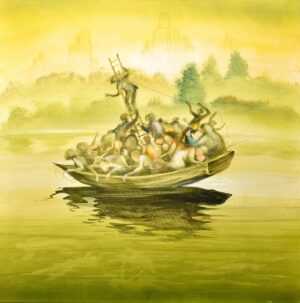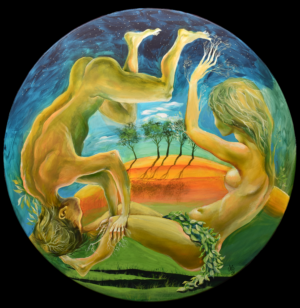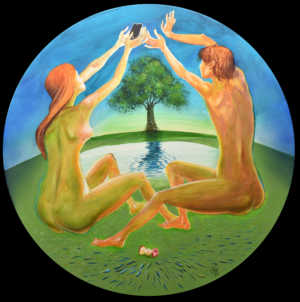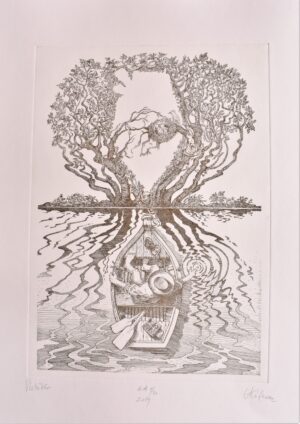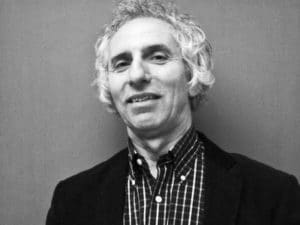 I was in a slightly easier position when I started my career as a visual artist, because I was born into a family of artists. My father, Fassel L' ousa Ferenc (1915-2009) graphic artist and painterőan artist who studied with the big names of the day and received a very thorough artistic education over six years at the then College of Applied Arts. He passed on this disciplined, thorough training in drawing and fine art to me. We had a lot of art books (no TV and no internet, thank God) and there was a constant stream of classical music, as I remember. Of course, the inheritance of talent is also important to progress in art, nem everywhere is legitimate. 1964–I was accepted to the Graphic Arts College, which was a big thing at the time. I think back with fond memories Gacs Gábor, Zala Tibor (our director at the time) László Miskolci, Gábor Pásztor, my teachers at the time. I did a lot of drawing beyond the compulsory tasks.
I was in a slightly easier position when I started my career as a visual artist, because I was born into a family of artists. My father, Fassel L' ousa Ferenc (1915-2009) graphic artist and painterőan artist who studied with the big names of the day and received a very thorough artistic education over six years at the then College of Applied Arts. He passed on this disciplined, thorough training in drawing and fine art to me. We had a lot of art books (no TV and no internet, thank God) and there was a constant stream of classical music, as I remember. Of course, the inheritance of talent is also important to progress in art, nem everywhere is legitimate. 1964–I was accepted to the Graphic Arts College, which was a big thing at the time. I think back with fond memories Gacs Gábor, Zala Tibor (our director at the time) László Miskolci, Gábor Pásztor, my teachers at the time. I did a lot of drawing beyond the compulsory tasks.
In the last three years I won drawing competitions, which helped me get into college. Successfully Signed up to the College of Fine Arts, despite the huge over-enrolment, and was admitted to the first year of the Applied Graphic Design course. Here too, drawing, painting and anatomy were the first subjects. Unfortunately, when I was supposed to specialise, the legendary Conecni George. My painting teacher was Szilárd Iván. I was still able to learn anatomy from the beloved Jenő Barcsay, who soon retired. Always mondin his characteristic high-pitched voice" You really like to draw..." Patay László, taught from a very different "perspective". Fortunately, there was a crossover between the disciplines. So I could Rozanits Tibor and Raszler Charles to make etchings. In the course Tamássi Zoltán and Zelenák Crescencia I had teachers. Towards my college years, I was making animated films, which was a precursor to my high school years when I went to the Pannoniaa Cartoon studio. With two animated films (one of them was a painting animation "Petőfi 73") I won the main prizes of the national festival in 1973 and '74, which was an entrance ticket to the Pannonia Film Studio. There I was a designer-director until 1991. At the beginning of my college years I changed my name to Cakó-ra.
One of my first paintings was a colourful picture I made for a children's drawing competition organised by the Puppet Theatre. I won first prize at the age of 6.
I've been influenced by a lot of classical and modern painters, although it's hard to know when and how they were incorporated intoz into one's consciousness the many experiences and sights. I believe that in the beginning it is not a bad idea to paint like the greats of old. I have never liked to copy, but I have painted self-portraits in the style of the German Low Countries, még about my friends. It's not a shame, because this is the moment of truth: what do I know, what don't I know, where am I, what direction should I take? Is–Do I have the technical skills?
I am basically a graphic designer. A real painter has a different vision. However, the combination of the two also produces different resultsto show.
In the gallery, I enjoy the work of painters who can combine drawing skills and painterly vision.
As a filmmaker and visual artist, I see things very differently.
Since I have been making animated films since the beginning, visual movement, dynamics and narration are very important to me. That's why I don't know what to do with non-figurative painting, which undoubtedly has some very beautiful pieces. I try to bring this dynamism, narrative and emotion into my paintings. I like to be "carried" by the image. So you can improvise, like in my sand-drawn films. I suppose it is this "free" drawing that has won me many international festival awards. A thorough training in fine arts has contributed a lot to the success of my films.
Inspiration is a difficult question. If you have to work in an industrial way, which is often the case, it can be called up out of routine, but the true one is that it strikes the artist in a calm, unruly state.
This is the real creative process, the driving force. Always have an idea that makes you feel good about working. If it meets the feelings of the audience, that's a miracle.
How many pictures I have painted in my life...I can't tell you. I do know that every 2-3 years I paintdI organised exhibitions, where I also tried to entertain the guests with live animated homo art. This is great, because in the end the audience is also involved in a creative process. They can experience the same when they see my sand performances projected on a large screen with a large orchestra as an evening programme, for example at the MÜPÁ-ban.(sand animation by ferenc cako).
I'm always looking at contemporary artists.
I spend quite a lot of time in the studio, which for me is divided into two areas: fine art and animation. They help and inspire each other. I try to bring a painterly quality to the homo animation and the dynamism of the films to the images.
Recharging is reading, photography, gardening and of course drawing with a pencil. Putting lots and lots of little ideas on paper that might later turn into a picture or a film. I have a lot of sketches. Of course, not all of them turn into something.
Achieving one's own style is not easy, but a lifetime is not enough for what an artist wants to express and create. A, set in the Middle Ages Pasolini film, where he was a painter working on a large mural. He would always have visions and then he would go to work quickly. When they took down the scaffolding, looks at his picture from afar "But I imagined it so beautifully".
I'm a musical omnivore, but I'm a fan of the classics.
I also like modern classical music, Bartók, Kodály, Respigni, Ravel, Bizet, etc.
It's not incidental how my films cover the visual moods with music. The choice of music for my live animated homage is also very important. What is the visual-sound co-location, which is a pleasure to do and which the audience likes.
Every artist wants to be able to show their work in the best possible places. This requires a great deal of tedious organisation, beyond the creation of the images. I'm happy to be in a large theatre, I receive invitations to live performances. It's also an exhibition, so to speak, because I can draw for an hour. And now it's fashionable to do visual art performance.
The style of a busy artist is constantly changing. Of course, it's great to be recognised by the style of the artist, but the good thing is, if all creators go through constant changes. I try to always strive for variety in technique and message.
There are a lot of old Roman painters whose work I like, but I also pay attention to sculptors. It's all there on the web now. It used to be that a painter would travel for weeks to see a painting by another artist.
At the age of 51, I was able to exhibit at the Vigadó, where I was able to perform live in the theatre hall.
I have achieved great international success mainly in animation for about 25 years. With my animated films, which are based on a very concentrated world of drawings and dramaturgy, and the drawings move, which is not incidental, becauset it takes months of work to achieve these spectacular results. That's why awards such as the Palme d'Or in Cannes, the Palme d'Or in Berlin
Golden Bear Award and much more. It's hard to get into a festival's competition programme, but winning one is a big deal.
In my free time sYou can garden and cook and spend a lot of time on the water, going on trips.
Now, during an epidemic, I start making etchings again. It's fantastic to work with this 500-year-old technique. I can finally exercise my graphic, drawing vein. Maybe I'll even make a film, although it's a lot of physical work if I'm moving it.
I would like to send a message to my dear customers who buy my paintings and those of others, to buy quality paintings from everyone and those with which you feel an emotional connection.
Ferenc Cakó
(1950 Budapest)
